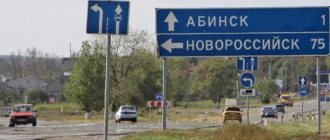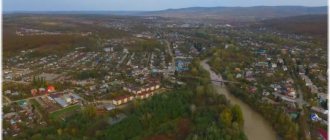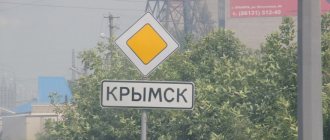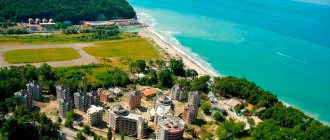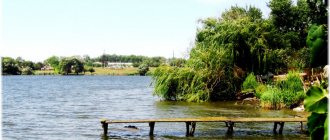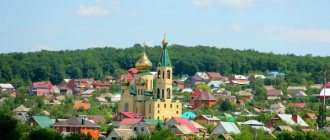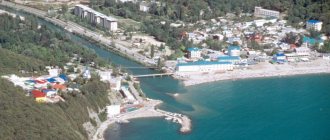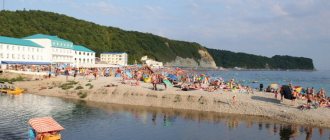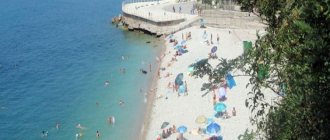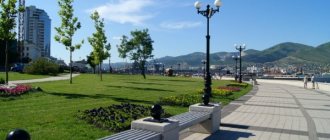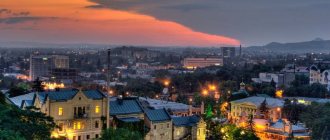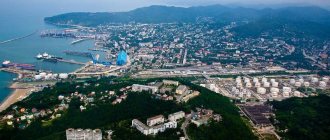| district[1] / municipal district[2] | |
| Timashevsky district | |
| Flag | Coat of arms |
- (22nd place)
- (11th place)
Timashevsky district
- administrative-territorial unit and municipal formation (municipal district) within the Krasnodar Territory of Russia.
The administrative center is the city of Timashevsk.
History[ | ]
- The Timashevsky district as part of the Kuban district of the North Caucasus Territory was formed on February 11, 1927 as a result of the transfer of the center of the Medvedovsky district
to the village of Timashevskaya and the renaming of the district to Timashevsky. Initially, the district included 16 village councils: Boykoponursky, Grechanobalkovsky, Derbentsky, Dneprovsky, Zarechensky, Kazache-Kirpilsky, Leninsky, Malininsky, Medvedovsky, Mogukoro-Grechany, Popovichevsky, Sergievsky, Starovelichkovsky, Timashevsky, Topoli, Khmelnitsky. - Since January 10, 1934, the region has been part of the Azov-Black Sea Territory.
- On December 31, 1934, as a result of disaggregation, part of the district’s territory became part of the newly formed Kaganovichi district with its center in the village of Popovichevskaya.
- Since September 13, 1937, the Timashevsky district has been part of the Krasnodar Territory.
- On August 22, 1953, the Rogovsky village council of the abolished Rogovsky district became part of the district.
- On February 1, 1963, the Timashevsky rural district was formed[6].
- On February 11, 1963, the district included the territories of the abolished Kalininsky and Primorsko-Akhtarsky districts.
- On January 12, 1965, the Primorsko-Akhtarsky district was restored to its former borders.
- On April 5, 1978, the Kalininsky, Kuibyshevsky and Starovelichkovsky village councils were transferred from the Timashevsky district to the restored Kalininsky district.
- In 1990, Timashevsk was given the official status of a city, and the head of the Timashevsky district, Lomach M.M., signed the order. and his deputy Telyashev O.N.
- In 1993, the activities of rural councils were discontinued, and the territories of rural administrations were transformed into rural districts.
- In 2005, 1 urban and 9 rural settlements were formed in the municipal region.
Timashevsk
Timashevsky kuren
At the end of the 18th century, on the right bank of the Kirpili River, where Timashevsk is now located, a deserted uninhabited steppe stretched. The history of the city begins in 1794, when Tymoshevsky (Timashevsky) kuren was founded among the first 40 settlements of the Black Sea Cossacks in the border Kuban.
According to one version, the name of the kuren and the city comes from the name of the young Cossack Timosh Fedorovich, one of the first settlers, the founders of the kuren. According to another version, the kuren was named after the village of Timoshovka in the Cherkasy region of Ukraine, where its first settlers came from; names of settlements based on the geographical origin of the inhabitants were widespread at that time in the Sich.
Initially, the Timashevsky kuren was located at a distance of 15 versts from the Ekaterinodar fortification. But soon, on the instructions of the Kosh Ataman Zakhary Chepega, the places of the kurens were determined by drawing lots, as a result of which the Timashevsky kuren was moved to the right bank of the Kirpili and located 73 versts from Yekaterinodar, where the city of Timashevsk is located to the present day.
According to the ancient custom that developed over many years of steppe wars, the Cossacks built temporary huts and tents, surrounded them with a dense ring of their carts and began building housing according to the boundary plan drawn up by the military surveyor, according to which all villages were built in the form of regular rectangles. The village was divided into nine blocks, the width of the streets was 10 fathoms. The central rectangular block was allocated for the church square.
In their villages, the Cossacks always sought first of all to build a temple. A year after the resettlement, a temporary church was erected in the Timashevsky Kuren. Later they raised money and erected a permanent church. The place where the memorial square is located today was at that time a church cemetery. The future Timashevsk began to be populated from the river. The streets were given simple, understandable names: Cossack (Cossacks settled here), Beregovaya (it stretched along the shore), Krasnaya (because it was beautiful). By decision of the Cossacks, Red Street was considered the main street of the kuren.
The first years of life in the Timashevsky village were difficult; in the desert region it was necessary to start everything from scratch: to build houses, roads, fortifications, bridges, post yards, and utility buildings. Women, old people, teenagers, disabled people and residents unfit for military service were engaged in farming, cattle breeding, fishing, hunting, and making clothing and household items. The Cossacks were busy with military service - they guarded the border with the Ottoman Empire, which at that time passed along the Kuban River.
Initially, the population of the Timashevsky kuren was small - 100 Cossacks fit for service (until 1861, only the Cossack population was listed in the census). Among the four kurens - Timashevsky, Rogovsky, Novokorsunsky and Medvedovsky - Timashevsky kuren was the most sparsely populated. After the abolition of serfdom, people were able to move around the country in search of a better life. In addition, since 1861, in order to quickly settle the Kuban region, the tsarist government allowed village communities to allocate small plots of land to non-residents for economic development, which contributed to population growth.
The management of the kuren was carried out on democratic principles. The Cossacks elected the ataman and his assistants, senior clerk, treasurer, judges and other officials. Any honest Cossack could be elected to any position, including atamans. If the elected ataman was illiterate, a seal was made with his last name, which was used to sign documents prepared by the clerk. The first elected ataman of the Timashevsky kuren was Shmalko.
Stanitsa Timashevskaya at the end of the 19th – beginning of the 20th centuries.
On July 1, 1842, the kuren received the status of a village, which became an important event for the Cossacks and was an impetus for further development. In 1874, the first school was opened in the village of Timashevskaya. In 1876, officers who participated in the Caucasian War were allocated 15 land plots for private ownership.
In the Collection of Information about the Caucasus for 1885 (volume XVIII), the village is indicated as Timoshevskaya. She owned 20,871 acres of land. In the village there were 303 courtyards and 393 houses, in which there were 2,423 residents of both sexes - 1,218 males and 1,205 females, of which 2,210 were native residents (1,107 men and 1,103 women), 110 non-residents who had settled life (59 men and 51 women), 103 are homeless (52 men and 51 women). In the village at that time there were: an Orthodox church, a men's school, 3 shops (1 with red goods and 2 with groceries), 2 drinking establishments, 4 flour mills, a tannery, a sheepskin factory, a cooperage establishment, 2 oil mills. Residents were engaged in arable farming and cattle breeding.
The Cossacks, leading a free lifestyle, were faced with a health problem that was very acute. Various epidemic diseases became a real scourge. Thus, cholera, which raged in 1871, 1880, 1888, claimed many lives. The problem of healthcare began to be systematically solved only after the establishment of Soviet power. And before that, in the village of Timoshevskaya there was only one paramedic station, located in two 12-meter rooms, in one of which medicines and documents were stored, and in the other, patients were received.
An important stage that played a significant role in the further development of the village was the construction of the Ekaterinodar - Yeisk (1911) and Ekaterinodar - Primorsko-Akhtarskaya (1916) railways. Bread harvested on the fertile Kuban lands began to be exported for sale to the central provinces of Russia and abroad. In 1912, a postal and telegraph office was opened in Timoshevskaya.
During the First Russian Revolution of 1905–1907, when many provinces were swept by the rise of revolutionary-minded masses, everything was calm in the village of Timashevskaya. The Cossacks, who had large plots of land and other privileges, remained loyal to the tsarist regime. And non-residents and artisans living in the village were largely dependent on the Cossacks and were divided. The news of the revolution of 1917 was greeted differently in the village - along with the opponents of the revolution, there were now many of its supporters. An important argument for supporters of the revolution was that with the overthrow of the tsar the war should end, which means husbands, sons and brothers would return home.
After the revolution, power in the village changed twice. In 1920, Soviet power was finally established in Timashevskaya. In the 1920s, efforts were made to develop healthcare. In 1924, the first hospital with 12 beds was opened in the former priest's house; its staff consisted of 6 people.
Until the 1920s the streets in the village had no names. In 1924, after the death of V.I. Lenin, one of the streets of Timashevsk was given the name of the leader, which it bears to this day. In the same year, the village of Prichipilovka, at the request of the citizens living there, was renamed Vladilenko.
On February 11, 1927, the center of the Medvedovsky district was moved to the village of Timashevskaya, and the district itself was renamed Timashevsky. Initially, the Timashevsky district included 16 village councils.
Stanitsa during the Great Patriotic War
The peaceful life of the village was disrupted with the beginning of the Great Patriotic War. On August 6, 1942, the Nazis entered the village, and long months of occupation began. The village of Timashevskaya, due to its convenient geographical location, was of strategic importance, so it was turned by the Nazis into a fortified citadel. The damage caused to the Timashevsky district during the stay of the German invaders on its territory amounted to almost 158 million rubles: railway stations were destroyed, many houses and libraries were burned and destroyed, dozens of hectares of orchards and vineyards were destroyed.
On February 10, 1943, the operation to liberate the Timashevsky district began with the advanced units of the 11th Guards Rifle Corps under the command of Lieutenant General I. L. Khizhnyak. On the same day, the village of Novokorsunskaya was liberated. At dawn on February 11, fighting broke out near the southwestern outskirts, and then in the center of the village of Timashevskaya. An unexpected blow from the Red Army forced the Nazis to run out of their houses in their underwear. By one o'clock in the afternoon on February 11, the Germans retreated, abandoning equipment and warehouses with property. The village of Timashevskaya was liberated from the invaders; on February 12, 1943, the Timashevsky district was completely cleared of German invaders.
Retreating, the Germans sought to cause maximum destruction; the dam, the cinema buildings, the editorial office of the regional newspaper, and the regional food processing plant were blown up. Great damage was caused to agriculture: out of 6,606 horses, less than 2,000 remained, out of 9,250 cows - about 1,270, only 40 birds were saved, and there were no pigs left at all. There was no more seeding wheat or fodder left.
The front was waiting for help from the rear, and the residents of the village tried to contribute to the cause of victory and restored the destroyed economy. In the shortest possible time, the dam was restored, the work of the railway depot was established, and the buildings were rebuilt. With an acute shortage of people and resources, in incredibly difficult conditions, the Timashevsky district exceeded the plan for meat production by 240 centners, milk by 33 centners, eggs by 30 thousand, grain by 12,317 centners.
The city of Timashevsk today
By decree of the Presidium of the Supreme Soviet of the RSFSR of December 30, 1966, the village of Timashevskaya was given the status of a city. This news was received with great joy and enthusiasm by former village residents, and now townspeople. On January 3, 1967, a meeting dedicated to this important event was held at the Zarya cinema. The cinema hall could not accommodate everyone. Many listened to the radio broadcast: “Now we are citizens!”
Thanks to the diligence of its residents, the former village with streets buried in dirt and dust turned into a large modern city, the center of a large agricultural region of Russia.
Today in Timashevsk there are 15 industrial and 5 agricultural enterprises, 15 kindergartens, 11 schools, a vocational school, an art and music school, 2 children’s and youth sports schools, 2 children’s creativity centers, 4 stadiums and a sports complex with a swimming pool, 2 hospitals, and also the only museum of the Stepanov family in Russia - a memorial museum telling about the life of an ordinary Russian peasant family.
Population[ | ]
| Population | ||||||||
| 1939[7] | 1959[8] | 1970[9] | 1979[10] | 1989[11] | 2002[12] | 2006[13] | 2010[14] | 2011[15] |
| 57 895 | ↗65 573 | ↗108 035 | ↘83 680 | ↗91 851 | ↗107 189 | ↘107 008 | ↘106 130 | ↘106 032 |
| 2012[16] | 2013[17] | 2014[18] | 2015[19] | 2016[20] | 2017[21] | 2018[22] | 2019[23] | 2020[24] |
| ↗106 928 | ↗108 301 | ↗109 292 | ↗110 262 | ↗111 186 | ↗111 544 | ↘110 447 | ↘109 282 | ↘108 360 |
| 2021[5] | ||||||||
| ↘107 901 | ||||||||
The population of the district as of January 1, 2006 was 107,008 people. Of these, 50.6% are urban residents and 49.4% are rural residents. Among the total population, men make up 46.9%, women – 53.9%. The female population of fertile age is 28,396 people (50.0% of the total number of women). Children from 0 to 17 years old - 23,199 people (21.7% of the total population), adults - 83,809 people (78.3%). Of the total population, 65,354 (61.1%) are people of working age, 21.4% are pensioners[25].
Administrative and municipal structure[ | ]
As part of the administrative-territorial structure of the region, the Timashevsky district includes 1 city of regional subordination and 9 rural districts[26][27].
As part of the organization of local self-government, the Timashevsky district includes 10 lower-level municipalities, including 1 urban and 9 rural settlements[28]:
| № | Municipality | Administrative center | Number of settlements | Population (persons) | Area (km²) |
| 1e-06 | urban settlement | ||||
| 1 | Timashevskoe | Timashevsk city | 2 | ↘50 640[5] | 187,30[4] |
| 1.000002 | Rural settlements | ||||
| 2 | Derbentskoe | Tantsura-Kramarenko village | 6 | ↗3464[5] | 86,65[4] |
| 3 | Dneprovskoe | village Dneprovskaya | 7 | ↘6450[5] | 122,04[4] |
| 4 | Kubanets | Bednyagina farm | 1 | ↘2589[5] | 72,82[4] |
| 5 | Medvedovskoe | village Medvedovskaya | 3 | ↘19 513[5] | 280,92[4] |
| 6 | Nezaimanovskoe | Nezaimanovsky farm | 3 | ↘2558[5] | 129,46[4] |
| 7 | Novokorsunskoe | village Novokorsunskaya | 2 | ↘5766[5] | 129,29[4] |
| 8 | Novoleninskoe | Leninsky farm | 5 | ↘3686[5] | 90,61[4] |
| 9 | Poselkovoe | Sovetsky village | 6 | ↘3553[5] | 170,15[4] |
| 10 | Rogovskoe | village Rogovskaya | 6 | ↘9682[5] | 237,19[4] |
Settlements[ | ]
In total, there are 41 settlements in the district, including 1 city and 40 rural settlements:
| List of settlements in the region | ||||
| № | Locality | Type | Population | Municipality |
| 1 | Timashevsk | city | ↘50 566[5] | Timashevskoye urban settlement |
| 2 | Barybinsky | farm | ↘280[14] | Novoleninskoe rural settlement |
| 3 | Poor thing | farm | ↘2589[5] | Kubanets, rural settlement |
| 4 | Bolshevik[29] | farm | ↗449[14] | Medvedovskoye rural settlement |
| 5 | Greblyansky | farm | ↗205[14] | Novoleninskoe rural settlement |
| 6 | Derbentsky | farm | ↗250[14] | Derbent rural settlement |
| 7 | Dimitrova | farm | ↗407[14] | Dnieper rural settlement |
| 8 | Dneprovskaya | village | ↘3165[14] | Dnieper rural settlement |
| 9 | Kalinina | farm | ↘392[14] | Dnieper rural settlement |
| 10 | Karl Marx | farm | ↘96[14] | Dnieper rural settlement |
| 11 | Brick | village | →74[5] | Timashevskoye urban settlement |
| 12 | Komsomol | village | ↘804[14] | Village rural settlement |
| 13 | Krasnoarmeisky | farm | ↘154[14] | Novokorsunskoe rural settlement |
| 14 | Krasnoarmeisky | village | ↘162[14] | Village rural settlement |
| 15 | Red | village | ↘180[14] | Village rural settlement |
| 16 | Red | farm | ↗385[14] | Rogovskoe rural settlement |
| 17 | Krupskaya | farm | ↘199[14] | Dnieper rural settlement |
| 18 | Kubansky | farm | ↘12[14] | Rogovskoe rural settlement |
| 19 | Lenin | farm | ↗566[14] | Dnieper rural settlement |
| 20 | Leninist | farm | ↘665[14] | Medvedovskoye rural settlement |
| 21 | Leninist | farm | ↗1845[14] | Novoleninskoe rural settlement |
| 22 | Lyutykh | farm | ↘200[14] | Derbent rural settlement |
| 23 | Medvedovskaya | farm | ↗16 793[14] | Medvedovskoye rural settlement |
| 24 | Peaceful | farm | ↘539[14] | Derbent rural settlement |
| 25 | Mozharian | farm | ↘34[14] | Nezaymanovskoe rural settlement |
| 26 | Nezaimanovsky | farm | ↘1809[14] | Nezaymanovskoe rural settlement |
| 27 | Nekrasova | farm | ↗159[14] | Rogovskoe rural settlement |
| 28 | Novokorsunskaya | village | ↘4945[14] | Novokorsunskoe rural settlement |
| 29 | New | farm | ↗605[14] | Novoleninskoe rural settlement |
| 30 | New | village | ↘85[14] | Village rural settlement |
| 31 | October | village | ↘224[14] | Village rural settlement |
| 32 | Olkhovsky | farm | ↗1020[14] | Dnieper rural settlement |
| 33 | Privokzalny | farm | ↘186[14] | Rogovskoe rural settlement |
| 34 | Postal | farm | ↗148[14] | Rogovskoe rural settlement |
| 35 | Rasp | farm | ↗283[14] | Novoleninskoe rural settlement |
| 36 | Rogovskaya | village | ↘7864[14] | Rogovskoe rural settlement |
| 37 | Garden | farm | ↘519[14] | Derbent rural settlement |
| 38 | Soviet | village | ↘1931[14] | Village rural settlement |
| 39 | Strinsky | farm | ↘598[14] | Nezaymanovskoe rural settlement |
| 40 | Tantsura-Kramarenko | farm | ↘1403[14] | Derbent rural settlement |
| 41 | Poplars | farm | ↗150[14] | Derbent rural settlement |
Elevator in Timashevsk
Hotels near the airport
Timashevsk does not have its own airport. The closest one is located near Krasnodar, 75 km away. Pashkovsky, according to reviews of people who moved to the Krasnodar Territory, is a large, modern airport, which is connected by flights to cities in Russia and other countries. Aircraft fly here from Moscow and St. Petersburg, Siberia and the Far East, from the Urals and the Volga region.
You can get from the airport to Timashevsk:
- By regular bus, which will take 1 hour 20 minutes, the ticket price starts from 143 rubles.
- Taxi, cost from 1300 rub.
- By rail (from Krasnodar).
There are many hotels located near the airport, which serves more than 3 million passengers a year.
Airport Hotel
The hotel is located 200 m from the airport terminal on the street. E. Bershanskaya, at house 355. Next to it there is a public transport stop leading to Krasnodar and other southern cities. Here guests are offered rooms ranging from 12 to 30 m2, which can accommodate 1-4 people.
All rooms have comfortable furniture and modern appliances, which makes them comfortable and cozy. The category ranges from Economy to Luxury. Rooms above “Standard” have private bathrooms with showers; in “Economy” the amenities are located in the hallway. For an additional fee you can get services here: transfer, laundry, food delivery to your room.
The hotel has a restaurant, a bar, and in the summer there is an additional cafe on the street. Breakfast (“continental”) is not included in the room rate, but you can pay for it if you wish. There is a mini-market on site. Cost of living – from 1500 to 3500 rubles.
Hotel Aerohotel
The hotel is located on the street. Fadeev at 328 a. From here to the air terminal - 800 m, there is a public transport stop nearby. The Aerohotel offers guests rooms and service of the European level. Everything here is arranged in such a way that guests feel care and comfort both during work and during rest.
The hotel rooms are decorated in a classic style; the designers used light, warm shades in the interiors. Bathrooms are equipped with towels, toiletries, bathrobes and slippers. Meals are served in a cozy cafe located in the same building. On the menu you can choose dishes from Russian and European cuisine. It’s a nice place to spend time with a cup of coffee or tea; the cafe offers a large selection of pastries and desserts from a local bakery.
For business negotiations, a conference room is available for rent, equipped with everything necessary for fruitful work. Internet is available throughout the entire territory. As additional services, it offers transfer from or to the city, cleaning clothes and shoes, ironing, luggage storage, and use of the library. Room price – from 2600 to 6300 rubles.
Hotel Pyramid
The hotel is located 2 km from the airport, in the village of Pashkovsky on the street. Fadeeva, 324/5. Not far from it there is a village stadium where you can play sports and an exhibition complex for an educational excursion. On the hotel territory there is a small but indoor year-round swimming pool, a large children's playground, and a sauna. Motorists can use parking.
The cozy rooms are decorated in light, uplifting colors. Their area allows you to organize not only a sleeping area, but also a working area and a place to relax with a TV and soft armchairs.
The bathrooms are equipped with modern plumbing fixtures, hygiene items, and sets of towels of different sizes. Guests are served in the restaurant; breakfast is not included in the room rate, but can be paid upon check-in. They make very tasty coffee here, and food can be delivered to your room. From the hotel you can get to Pashkovsky Airport or Krasnodar railway station by minibus N 15, stop on the street. March 8.
Timashevsk in the Krasnodar region arose in 1794 at the behest of Catherine II as a small Cossack kuren. It was built and developed mainly by immigrants from other villages and regions. According to reviews of people who moved here for permanent residence, it is now a large industrial city with a well-developed infrastructure and many enterprises that provide local residents with a comfortable existence.
Economics[ | ]
Timashevsky district is an economically developed agro-industrial region of Kuban. There are 55 large enterprises in the region, of which 16 are budget-generating, more than 1,200 small and medium-sized enterprises, about 200 trade and catering enterprises, 364 peasant farms.
Production and processing of agricultural products are priority areas for the development of the region. The agricultural sector of the economy is the main socially significant one and the activities of the processing complex directly depend on its activities.
At the end of 2007, grain production amounted to more than 300 thousand tons, sunflower - 40 thousand tons, sugar beets - about 100 thousand tons. Gross milk production is 46 thousand tons.
Notes[ | ]
- from the point of view of the administrative-territorial structure
- from the point of view of the municipal structure
- Structure of the administration of the municipal district Timashevsky district Official website of the municipal formation "Timashevsky district"
- ↑ 1234567891011
Krasnodar region. Total land area of the municipality - ↑ 123456789101112131415
The permanent population of the Russian Federation by municipalities as of January 1, 2022 (Russian). Retrieved April 27, 2022. Archived May 2, 2022. - Decree of the Presidium of the Supreme Soviet of the RSFSR dated 02/01/1963 (unspecified)
. www.libussr.ru. Date accessed: May 25, 2022. - All-Union Population Census of 1939. The current population of the USSR by regions and cities (unspecified)
. Retrieved November 20, 2013. Archived November 16, 2013. - Population of the USSR according to the census as of January 15, 1959 by republics, territories, regions, national districts, districts, cities, urban-type settlements, regional centers and large rural settlements (according to administrative-territorial division as of January 1, 1960) (unspecified
.) . Moscow: Central Statistical Directorate under the Council of Ministers of the USSR (1960). Archived from the original on August 23, 2011. - All-Union Population Census of 1970 (unspecified)
. Archived November 3, 2011. - All-Union Population Census of 1979 (unspecified)
. Archived November 3, 2011. - All-Union population census of 1989. Population of the USSR, RSFSR and its territorial units by gender (undefined)
. Archived from the original on August 23, 2011. - All-Russian population census 2002. Volume. 1, table 4. Population of Russia, federal districts, constituent entities of the Russian Federation, districts, urban settlements, rural settlements - regional centers and rural settlements with a population of 3 thousand or more (unspecified)
. Archived from the original on February 3, 2012. - Department of Health of the Krasnodar Territory, Timashevsky district
- ↑ 1 2 3 4 5 6 7 8 9 10 11 12 13 14 15 16 17 18 19 20 21 22 23 24 25 26 27 28 29 30 31 32 33 34 35 36 37 38 39
All-Russian population census 2010
. Volume 1, table 4. Urban and rural population by gender in the Krasnodar Territory (unspecified)
. Retrieved January 2, 2015. Archived January 2, 2015. - Krasnodar region. Estimated resident population as of January 1, 2009-2014
- Population of the Russian Federation by municipalities. Table 35. Estimated resident population as of January 1, 2012 (unspecified)
. Retrieved May 31, 2014. Archived May 31, 2014. - Population of the Russian Federation by municipalities as of January 1, 2013. - M.: Federal State Statistics Service Rosstat, 2013. - 528 p. (Table 33. Population of urban districts, municipal districts, urban and rural settlements, urban settlements, rural settlements) (undefined)
. Retrieved November 16, 2013. Archived November 16, 2013. - Population estimate as of January 1, 2014 for municipalities of the Krasnodar Territory (unspecified)
. Retrieved April 27, 2014. Archived April 27, 2014. - Population of the Russian Federation by municipalities as of January 1, 2015 (unspecified)
. Access date: August 6, 2015. Archived August 6, 2015. - Population of the Russian Federation by municipalities as of January 1, 2016 (Russian) (October 5, 2018). Retrieved May 15, 2022. Archived May 8, 2022.
- Population of the Russian Federation by municipalities as of January 1, 2022 (Russian) (July 31, 2017). Retrieved July 31, 2022. Archived July 31, 2022.
- Estimated population as of January 1, 2022 for municipalities of the Krasnodar Territory (unspecified)
. Date accessed: March 23, 2022. - Population estimate as of January 1, 2022 for municipalities of the Krasnodar Territory (unspecified)
. Access date: April 10, 2022. - Estimated population as of January 1, 2022 for municipalities of the Krasnodar Territory (unspecified)
. Access date: April 16, 2022. - Department of Health of the Krasnodar Territory, Timashevsky district
- Law of the Krasnodar Territory of July 2, 2009 No. 1765-KZ “On the administrative-territorial structure of the Krasnodar Territory and the procedure for changing it”
- Administrative and territorial division of the region for 2022
- Law of the Krasnodar Territory of May 05, 2004 N 698-KZ “On establishing the boundaries of the municipal formation Timashevsky district, giving it the status of a municipal district, the formation of municipalities within it - urban and rural settlements - and establishing their borders” // Electronic Fund of Legal and normative and technical documentation.
- former Lebedinsky farm
Timashevsk hotels on the map
Timashevsk in the Krasnodar Territory (reviews from those who have moved draw the attention of guests to the fact that the city has many hotels of different categories, levels of service and cost) is distinguished by the concentration of hotels in the city center. Only a few of them are located on the outskirts or in the industrial zone.
Hotel Tourist
The hotel is located 3 km from the city center at the address: st. Turgeneva, 18. The newly opened premises have 14 comfortable rooms with pleasant interiors, new furniture, modern plumbing and LCD TVs. Additional services include free Wi-Fi, parking, and laundry. At the administration desk, which is open 24 hours a day, you can order and purchase train and plane tickets.
The furnishings of the rooms are thought out and designed to ensure the required comfort. There are single and double beds, wardrobes, desks; Superior rooms have upholstered furniture, coffee tables, and a coffee machine. All rooms have air conditioning. Bathrooms are equipped with sets of towels and hygiene products, hair dryers, bathrobes and slippers.
Breakfast is available at an additional cost. Within walking distance from the hotel there are cafes, food and department store stores, and you can get to the railway station by taxi in 10 minutes. Room price – from 900 to 2100 rubles. The city's main attractions are located 2-3 km from this hotel.
Hotel Swedish Village
At the address: st. 70 Let Oktyabrya, 6a, in the Sadovod microdistrict there is the Swedish Village hotel, which offers guests rooms of three categories, designed for 1-3 people:
- Economy;
- Standard;
- De Luxe.
A large family can be accommodated in a villa of 170 m2, which has 2 bedrooms with bathrooms, a common living room, and a kitchen. The villa has a sauna, garage and laundry room. The hotel is located in a quiet location, on the river bank. On its territory there is an outdoor swimming pool with heated water, a billiard room, board games, a sauna for 6 people and a gym.
Two conference rooms equipped with the necessary video and sound equipment allow you to combine a production meeting with relaxation. The halls are designed for 10 and 40 people. The entire area is covered by a Wi-Fi network.
The hotel has a restaurant; breakfast is included in the room price and is served as a buffet. Cars can be left in a guarded parking lot. Cost of living – 2200-4400 rubles. Estimated check-in and check-out time is 12-00. Directions: from the railway station and bus station, take minibus N1 to the Druzhba stop. Then walk 3 minutes.
Hotel Phaeton
There is a hotel on Kotlyara Street at 222, only 400 m from the railway station. Its 15 rooms, which were commissioned in 2008, are decorated in a calm classic style and offer comfortable accommodation for 1-4 people. The furnishing of the rooms provides for zoning of the premises: there are sleeping and working areas, as well as a mini-living room.
The rooms have single and double beds, desks with chairs, bedside tables, and armchairs. The rooms have refrigerators, LCD TVs, and air conditioning. Newlyweds and couples are provided with a special “Romantic” room. The hotel has a cafe from 8-00 to 23-00 that can deliver food to your room. It provides its halls for organizing banquets. The cost of rooms without meals is in the range of 1000-3500 rubles.
Hotel Teta
The address of the modern hotel, operating since 2013, is st. Internatsionalnaya, building 11. The fund of 16 rooms of different categories is designed to accommodate 1-3 people on an area from 18 to 30 m2. The rooms have modern furnishings, private bathrooms, TV and air conditioning.
The hotel has a restaurant that offers a varied menu. Breakfast can be paid for at any time at the guest's request; it is possible to book a room without it. Cost of living – from 1650 to 4050 rubles. Travel to the hotel from the railway station is possible by minibuses NN 4 and 11 to the “Central Market” stop. You can walk to the bus station.
